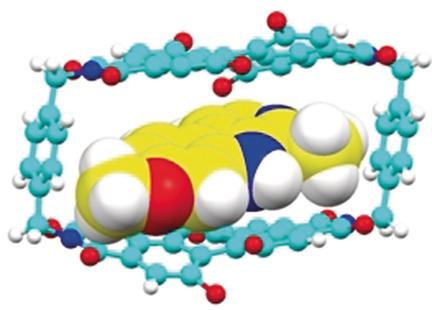当前位置:
X-MOL 学术
›
Angew. Chem. Int. Ed.
›
论文详情
Our official English website, www.x-mol.net, welcomes your feedback! (Note: you will need to create a separate account there.)
A Water‐Soluble Perylene Bisimide Cyclophane as a Molecular Probe for the Recognition of Aromatic Alkaloids
Angewandte Chemie International Edition ( IF 16.1 ) Pub Date : 2019-01-31 , DOI: 10.1002/anie.201813559 Meike Sapotta 1 , Anja Hofmann 1 , David Bialas 1 , Frank Würthner 1, 2
Angewandte Chemie International Edition ( IF 16.1 ) Pub Date : 2019-01-31 , DOI: 10.1002/anie.201813559 Meike Sapotta 1 , Anja Hofmann 1 , David Bialas 1 , Frank Würthner 1, 2
Affiliation

|
Herein, we report a water‐soluble macrocyclic host based on perylene bisimide (PBI) chromophores that recognizes natural aromatic alkaloids in aqueous media by intercalating them into its hydrophobic cavity. The host–guest binding properties of our newly designed receptor with several alkaloids were studied by UV/Vis and fluorescence titration experiments as the optical properties of the chromophoric host change significantly upon complexation of guests. Structural information on the host–guest complexes was obtained by 1D and 2D NMR spectroscopy and molecular modelling. Our studies reveal a structure–binding property relationship for a series of structurally diverse aromatic alkaloids with the new receptor and higher binding affinity for the class of harmala alkaloids. To our knowledge, this is the first example of a chromophoric macrocyclic host employed as a molecular probe for the recognition of aromatic alkaloids.
中文翻译:

水溶性Per双酰亚胺环芳烃作为识别芳香生物碱的分子探针
本文中,我们报告了一种基于per双酰亚胺(PBI)生色团的水溶性大环主体,该主体通过将亲水性生物碱插入其疏水腔中来识别水性介质中的天然芳香族生物碱。我们通过紫外线/可见光和荧光滴定实验研究了我们新设计的受体与几种生物碱的主体-客体结合特性,因为发色主体的光学特性会在客体络合后发生显着变化。通过1D和2D NMR光谱学和分子建模获得了宿主-客体复合物的结构信息。我们的研究揭示了一系列结构多样的芳香族生物碱与新受体的关系,以及对harmala生物碱类的更高结合亲和力。据我们所知,
更新日期:2019-01-31
中文翻译:

水溶性Per双酰亚胺环芳烃作为识别芳香生物碱的分子探针
本文中,我们报告了一种基于per双酰亚胺(PBI)生色团的水溶性大环主体,该主体通过将亲水性生物碱插入其疏水腔中来识别水性介质中的天然芳香族生物碱。我们通过紫外线/可见光和荧光滴定实验研究了我们新设计的受体与几种生物碱的主体-客体结合特性,因为发色主体的光学特性会在客体络合后发生显着变化。通过1D和2D NMR光谱学和分子建模获得了宿主-客体复合物的结构信息。我们的研究揭示了一系列结构多样的芳香族生物碱与新受体的关系,以及对harmala生物碱类的更高结合亲和力。据我们所知,











































 京公网安备 11010802027423号
京公网安备 11010802027423号